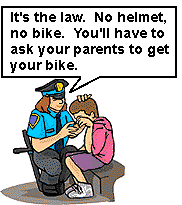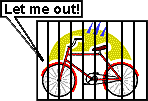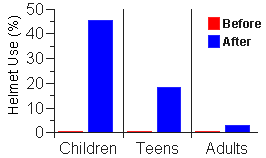|
July 13, 2000  It's a warm summer day. It's a great day for a bike ride. Are you
wearing your bicycle helmet? I hope you are. Read these statistics:
It's a warm summer day. It's a great day for a bike ride. Are you
wearing your bicycle helmet? I hope you are. Read these statistics:
- About 27.7 million children under the age of 15 years ride bicycles in
the US.
- In 1997, about 367,700 children went to the emergency room for a
bicycle-related injury; about 30% of these children had a head, face or
ear injury.
- In 1997, 224 children were killed in bicycle-related accidents; about
66% of these children had head injuries.
- In the US in 1994, only 50% of the children who rode bikes said they
owned a bike helmet; only 25% of the children who rode bikes said they
wore a helmet every time they rode their bikes.
- Studies indicate that bicycle helmets prevent 69% to 88% of serious
head or brain injuries.
(Statistics referenced in Gilchrist et al.,
Pediatrics, 106:6-9, 2000)
Because statistics don't seem to influence riding habits, a new report
details another way to get kids to wear their helmets:
NO HELMET, NO BIKE
 In 1997, Dr. Julie Gilchrist led a team of researchers from the Centers for Disease Control and Prevention and
the Georgia Department of Human Resources to the small town of Wadley,
Georgia (population 2,400). The state of Georgia had passed a law in 1993
that said all bicycle riders under the age of 16 years must wear a helmet.
Although parents could be given a ticket if their children did not wear a
helmet, the law was rarely enforced. The town of Wadley then added
another twist to the law books: if a child under the age of 13 years did
not wear a helmet when riding, the police could confiscate the child's
bike. Parents would have to come to the police station to pick up the
bike.
In 1997, Dr. Julie Gilchrist led a team of researchers from the Centers for Disease Control and Prevention and
the Georgia Department of Human Resources to the small town of Wadley,
Georgia (population 2,400). The state of Georgia had passed a law in 1993
that said all bicycle riders under the age of 16 years must wear a helmet.
Although parents could be given a ticket if their children did not wear a
helmet, the law was rarely enforced. The town of Wadley then added
another twist to the law books: if a child under the age of 13 years did
not wear a helmet when riding, the police could confiscate the child's
bike. Parents would have to come to the police station to pick up the
bike.
The study carried out by Dr. Gilchrist had two parts. First, in April
1997, helmets were given to all 426 students in the elementary school and
to approximately 150 middle school students. Students and their parents
also received bicycle safety instruction. Second, following the
distribution of helmets, the police started to enforce the law and take
bikes away from helmetless riders.
 When the researchers surveyed people before the study began,
they found that NO ONE in the town used a helmet and that only 8% of the
children in kindergarten through fifth grade even owned a helmet. During
a five-month period, workers positioned themselves around town and
recorded how often helmets were being used. When the researchers surveyed people before the study began,
they found that NO ONE in the town used a helmet and that only 8% of the
children in kindergarten through fifth grade even owned a helmet. During
a five-month period, workers positioned themselves around town and
recorded how often helmets were being used.
The police impounded a total of 167 bicycles (about 33 per month) after
the program began. In children between the ages of 5 and 12 years, helmet
use went from 0% before the program to 45% after enforcement of the law.
Teens (13-15 years) use of helmets increased to 18%. It was disappointing
to see that adult helmet use increased to only 3%.
Helmet Use Before And After Police Enforcement

 This study suggests that police enforcement of helmet laws has a
significant effect on helmet use. When the police have the power to take
away bikes, kids will wear their helmets. Whether this program of helmet
distribution, safety education and bicycle impoundment will increase the
use of helmets in larger cities remains to be seen. Moreover, the law
only targeted kids under the age of 13 years. More studies are needed to
see if teenagers and adults would also be motivated to wear helmets if the
police could take their bikes.
This study suggests that police enforcement of helmet laws has a
significant effect on helmet use. When the police have the power to take
away bikes, kids will wear their helmets. Whether this program of helmet
distribution, safety education and bicycle impoundment will increase the
use of helmets in larger cities remains to be seen. Moreover, the law
only targeted kids under the age of 13 years. More studies are needed to
see if teenagers and adults would also be motivated to wear helmets if the
police could take their bikes.
 Although losing your bike because you did not wear your helmet may seem
like a severe penalty, the law is meant to protect you. The brain is a
delicate and fragile organ. It contains all of your memories and your
ability to form new ones. It is everything you were and everything you
will be.
Although losing your bike because you did not wear your helmet may seem
like a severe penalty, the law is meant to protect you. The brain is a
delicate and fragile organ. It contains all of your memories and your
ability to form new ones. It is everything you were and everything you
will be.
Protect your brain! Wear a
helmet!
Reference and more information:
- Gilchrist, J., Schieber, R.A., Leadbetter,
S. and Davidson,
S.C. Police enforcement as part of a comprehensive bicycle helmet program.
Pediatrics (July issue), 106:6-9, 2000.
- Ultimate
Bicycle Safety Guide
|


![[email]](./gif/menue.gif)

